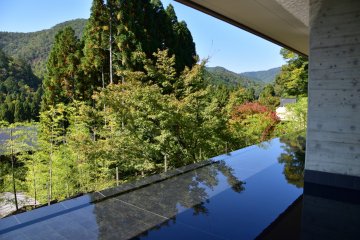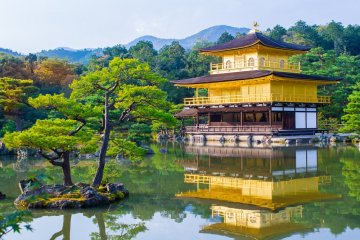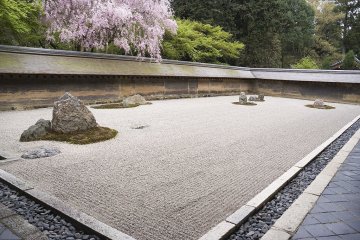
Jalur Maple Kitano Tenmangu
Mandy BartokJalur maple Kitano Tenmangu merupakan tambahan terbaru ke daftar spot dedaunan musim gugur yang berharga di Kyoto.

Known for its academic blessings, Kitano Tenmangu is a Shinto shrine in Kyoto’s Kamigyo ward that is dedicated to Sugawara no Michizane, an influential scholar and politician. The shrine was built in 947 AD and is Japan’s first shrine to enshrine an actual person as a deity. Although there are numerous shrines throughout Japan dedicated to Michizane who is mainly known as a god of academics, Kitano Tenmangu is the original one.
The massive Ro-mon Gate stands as the border between the city and the shrine grounds. This wooden structure, detailed with gold-and-wooden carvings, serves as an introduction to the architectural mastery ahead. Upon entering, it is customary to go to the chozuya and perform a hand-cleansing ritual. After you complete the ritual, explore the shrine’s tranquil grounds.
There are city buses running frequently from Kyoto station to the Kitano Tenman-gu-mae bus stop, which would cost you around ¥230 and will take around 30 minutes.

Jalur maple Kitano Tenmangu merupakan tambahan terbaru ke daftar spot dedaunan musim gugur yang berharga di Kyoto.

Hotel cantik yang terletak di Shozan Resort Kyoto yang bersejarah.

Staf, lokasi, dan kualitas fantastis - Hotel MyStays Kyoto Shijo

Hostel yang terletak di Kawaramachi, jantung kota Kyoto ini menurut saya adalah opsi terbaik yang bisa pejalan dapatkan ketika berkunjung ke Kyoto. Selain letaknya yang strategis, hostel ini juga memiliki harga yang bersahabat, bangunannya baru dibuat, fasilitas yang baik dan tentunya staf yang bersahabat.

Seiring dengan pertumbuhan ketenaran veganisme, khususnya di Jepang, para vegan sekarang bisa menikmati ramen yang sepenuhnya vegetarian dan cabang restoran vegetarian lainnya di negara ini. Berikut adalah tiga tempat yang dapat dikunjungi di Kyoto.

Grand Burger di Kyoto menghidangkan burger lezat di sebuah tempat makan yang nyaman, hanya beberapa langkah dari dinding Istana Kekaisaran

Kedai soba berdiri dengan beragam menu lezat serta harga yang sangat terjangkau yang dapat ditemui di pusat kota Kyoto.

Kuil Kinkakuji juga dikenal sebagai Golden Pavilion (Paviliun Emas) di utara Kyoto. Dua lantai teratas dari paviliun ditutupi daun emas dan dikelilingi dengan kolam yang luas, refleksi dari kuil benar-benar menakjubkan. Anda dapat mengikuti jalan yang akan memandu Anda berkeliling area kuil dan setelah Anda selesai, Anda dapat menikmati teh dan pencuci mulur dikelilingi dengan pepohonan untuk mengistirahatkan tubuh Anda dan membeli beberapa suvenir jika Anda mau di toko suvenir pada akhir perjalanan Anda.

Keishunin (桂春院) is one of the sub-temples of Myoshin-ji containing gardens and a teahouse.

Ryoanji Temple is home to Japan’s most famous Zen stone garden and one of Kyoto’s most iconic scenes. Believed to be built back in the Muromachi period (14th - 16th century), the origin and designer of the garden is still unknown to this day. The stones in the garden are intentionally placed so that one cannot view all 15 stones from any one angle. The meticulous design of this karesansui (Japanese rock garden) leads many to credit the celebrated artist, Soami, as the garden’s creator—albeit unproven. The 248-square meter garden bears little trace of greenery, and is instead immaculately lined with raked white gravel. The seemingly random placement of the stones adds to the mystique of Ryoan-ji, its abstract layout leaving visitors questioning the meaning and purpose of the garden. While the garden remains a mystery, the history of Ryoanji Temple is well documented. The temple buildings were originally a Heian Period villa, and were converted into a Zen temple in 1450. Now, Ryoanji is part of the Myoshin-ji school in the Rinzai sect of Zen Buddhism. In 1994, Ryoanji’s immaculate zen stone garden was recognised as a UNESCO World Heritage Site, and is also designated as a Historic Monument of Ancient Kyoto.